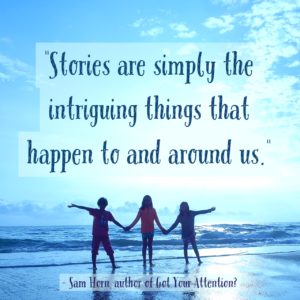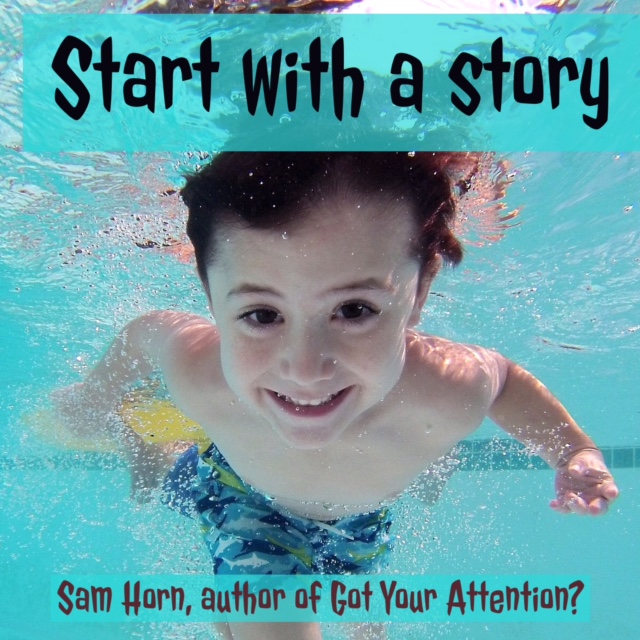A new client told me, “I don’t have any stories.” I told her, “We ALL have stories. Stories are simply the intriguing things that happen to or around us.”

She came back with, “But I wouldn’t know how to tell a story even if I had one.”
I promised to share this post which shows how to notice and collect real-life stories and re-enact them so they come alive. First, I’ll start with a story.
Several summers ago, I realized how sedentary I’d become. Like many Americans, I spend 12 hours a DAY sitting and it had taken a toll on my health.
I decided to change things up. I lived on a lake outside Washington DC in a community with 20 public pools. I vowed to swim four times a week and to visit every single one of the pools in my neighborhood by Labor Day weekend.
One sunny afternoon, after a long day of writing, I decided it was time to get up and get moving. I jumped in my van and went “pool shopping.” I noticed a new pool I hadn’t tried before tucked under some shade trees, parked and went in.
As soon as I walked in, I realized I’d found the “family” pool. The place was packed with kids playing Marco Polo and featured one of those mushroom-shaped fountains in the wading pool. It did my heart good to know kids still play Marco Polo.
I found a chaise lounge next to a woman watching her three young kids. Just then, a man wearing a business suit walked in. The three kids bounded out of the pool and ran to meet him, calling out “Daddy, Daddy.”
He hugged them, gave his wife a peck on the cheek and headed to the locker room to change into his swim trunks. Moments later, he was in the pool with his kids. They were diving off his shoulders and proudly showing him the strokes they’d learned in their swim lessons. It was a scene right out of a Norman Rockwell painting.
All of a sudden, he paused, looked up at his wife almost in a state of wonderment and said, “Hon, why don’t we make this our default? Why don’t we meet at the pool every night after work?”
I have to admit, I held my breath. I looked at her, thinking, “Please say yes.”
She thought about it for a moment, nodded and said simply, “Why don’t we?”
In five seconds, they abandoned an old default and adopted a new one. Instead of, “Get up, go to work, come home;” it was now “Get up, go to work, go to the pool, come home.”
Who knows, that family may always remember that summer as the one they met Dad at the pool every night after work. Perhaps I”m being a Pollyanna about this, but maybe they will remember that summer as the one everything was right with their world.
So, what’s this got to do with you? Imagine you’re giving a presentation about changing habits. Or you’re talking to your team about the dangers of sitting for hours at at a time, all day, every day.
You could start by sharing research that explains how difficult it is to adopt new habits. You could begin with a study that reveals sitting is considered the “cigarettes of our era” in terms of how hazardous it is to our health.
Or you could start off with a story SHOWING how someone changed a habit that lead to a more positive, productive, proactive life. You could start off with a real-life example of someone who, in seconds, replaced an old default with a new default that immediately benefited them and everyone involved.
Which do you think will be more effective?
In today’s world of INFObesity (information that comes across as blah-blah-blah) people are more likely to relate to and remember real-life stories that show vs. tell.
Are you thinking, “But I don’t have any stories.” or “I’m not good at telling stories?”The good news? Remember, stories are simply the intriguing things that happen to you and around you.
Ask yourself, “What point do I want to make in my presentation or in this meeting?” Or, “What is the SHIFT I want my listeners, readers, employees to make?” Then ask yourself, ‘Where have I seen someone DO that, LEARN that, EXPERIENCE that at work, at home or in my community?”
Now, all you have to make that story come alive is to “put people in the S.C.E.N.E” by re-creating what was said and done. Re-enact that experience with these five tips so people feel it’s happening to or around them, right now.
The key to making a story believable and relatable is not to make it up. it’s to re-enact something that actually happened so people trust it and you.
When you put people in the S.C.E.N.E., you’re not “telling a story,” (which some skeptics may suspect you got off the internet); you’re sharing a real-life example that shows what you’re suggesting has worked for others – and how it can work for everyone listening and reading too.
TIPS FOR SHARING A STORY BY PUTTING PEOPLE IN THE S.C.E.N.E.
S = SENSORY DETAIL: Describe the time, place and location with just enough vivid sensory detail so we feel like we’re standing or sitting right next to you. Describe what it looked like – maybe even what it smelled like, tasted like, felt like, sounded like – so we’re seeing it in our mind’s eye.
C = CHARACTERS: Who is in the scene? Describe the individuals involved so we can picture them and so we know their MOOD. Are they busy, frazzled and stressed? Happy? Angry? Excited? What’s his/his name? If you want us to CARE about your CAREacters, flesh them out so we feel we know them.
E = EXPERIENCE IT: Robert Frost said, “No tears in the writer, no tears in the reader.” I think, “No epiphany in the speaker, no epiphany in the listener.” This may be the hundredth time you’ve told this story, but if you mentally put yourself back in the scene, re-experience it as if it’s the first time, and re-enact it as if it’s happening NOW, you will feel what you felt then – and we will too.
N =NARRATIVE: Why can we read novels for hours at a time and it’s not hard work? It’s because authors use narrative – e.g., “He said, She said” – so we feel we’re right in the middle of the conversation. Simple said, narrative is a non-negotiable if you want your story to come alive. Include who said what with comma/quotes “(i.e., “He said, “Why don’t we change our default.” She said, ”Why don’t we?.”) so your story is organic, original and REAL.
E = EPIPHANY: What is the lesson-learned, the happy ending, the problem that was solved, the shift that occurred, the aha where the light comes on, the band plays and it all makes sense? Every story needs a “moral of the story” so it achieves a purpose and the audience gets the point. What’s yours?
A mantra of the speaking profession used to be, “Make a point, tell a story.” That advice is outdated. In these days of short-attention-spans and INFObesity, if you take too long to make your point, people will never make it to the story.
As John Steinbeck said, “If there’s magic in story-telling, and I’m convinced there is, the formula seems to lie solely in the aching urge to convey something you feel is important.”
If you START WITH A STORY and put people in the S.C.E.N.E of a true experience that’s important to you and that illustrates your idea … it will eloquently make your point for you.
Better yet, if you relive that experience in your mind and vividly remember what it felt like, your audience will feel what you felt. That is connection, and that is the point of all communication … to connect, always to connect.
– – – –
Sam Horn, Founder/CEO of the Intrigue Agency and TEDx speaker, is on a mission to help people create respectful, one-of-a-kind communications that add value for all involved. Her work – including IDEApreneur, Tongue Fu! POP! and Washington Post bestseller Got Your Attention? – has been featured on NPR and in New York Times and presented to National Geographic, Boeing, Cisco, Capital One.

